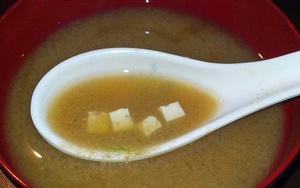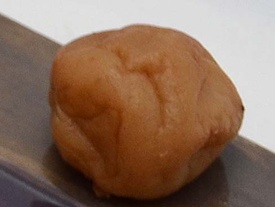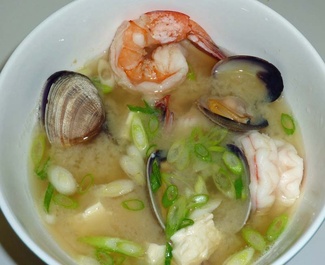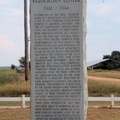If you have been to a Japanese restaurant in the United States, you probably have been served a warm, salty, light brown miso soup. Sometimes it will have thinly sliced scallions floating in the broth. Sometimes there will be miniature cubes of tofu hidden in the depths below the particles of miso suspended in the broth. It is offered more as an afterthought, usually before a meal of overly large portions of protein or sushi.
My daughter, Elizabeth, came back from Japan this spring with a revelation—Japanese miso soup is nothing like the miso soup you get in a Japanese restaurant in the United States! She also discovered that miso can be a meal unto itself with a broth of deep flavors and aromas. Rich with seafood—clams, shrimp, and fish. It was more a miso stew than a miso soup.
She wanted to try to reproduce that soup in our kitchen, but didn’t know where to start. Maybe it’s my creeping old age, but I couldn’t remember the last time that I made miso soup, or if I had ever made miso soup as an adult. I know for certain that I have never made the miso based soup of the kind she got in Japan.
So, on an extremely summer hot weekend, not long after she returned from Japan, I decided that the time was right for us to make a miso soup comparable to the ones she had in Japan. Without too much of a clue of what we needed, we drove to Oto’s Marketplace, a family-run supermarket in Sacramento that specializes in Japanese and Asian foods.
We wandered the aisles looking at the variety of packaged goods from Japan, Korea, and China trying to decide what we needed. The young store clerk stocking shelves smirked slightly as he asked us if we needed help. Obviously we did, but being male and the father I couldn’t admit to that. I asked for the location of dashi, a dehydrated fish soup base, which was directly behind of us. After that, I was on a roll. I found the kombu, dried kelp. Tofu, another essential ingredient, was in the refrigerated case nearby.
I couldn’t remember the name of another ingredient, but I knew it by sight in the boxes of katsuo-bushi on the shelf. Katsuo-bushi are flakes of dried, shaved bonito. Growing up on the family farm, we weren’t wealthiest of families, so we would have simple meals of rice, vegetables, and plain tofu. To dress up the tofu, we would sprinkle it with katsuo-bushi and shoyu, giving it texture, flavor, and adding more protein.
I couldn’t help but stop to look at all the varieties of umeboshi, a certain type of plum cured in salt with shiso leaves. The tartness and smell of umeboshi reminds me of my childhood. Mom used it as a cure-all for whatever ailed us. Have the mumps? Mom made a poultice of umeboshi wrapped in a towel to put on our cheeks. Have an upset stomach? Mom would pop out a couple of umeboshi for me. For me, it’s great on plain, hot white rice with nothing else.
Elizabeth and I continued to wander in Oto’s looking for other ingredients. The only fresh clams they had at the time were small Manila clams. They had three or four types of shrimp—small, medium, large, and jumbo. Not knowing how much we would need, we got half a pound of both the Manila clams and large shrimp.
Last was the miso, a paste made of fermented soybeans and rice. Who knew that there are so many different kinds and brands! Shiro (white), aka (red), organic, low salt, miso made from barley and buckwheat. The store clerk with the smirk stops again to ask if we need help. Oto’s staff is quite helpful. I see one brand of miso in a green and white tub that looks familiar. It is the brand Mom used to buy decades ago. It is a shiro-miso, mild in flavor, as opposed to an aka-miso that is darker and has a stronger flavor.
On the long drive home, we talked about how we are going to make the soup. I had not much more than a vague idea of how the stock will be made from memories of the Japanese Iron Chef series.
Once home, we began by shelling and deveining the shrimp. The Manila clams were scrubbed and placed in salted water. Elizabeth started the broth by boiling water in a saucepan. Into the water, she added a package of dashi, a strip of kombu, a package of the katsuo-bushi and, not to be wasted, the shrimp shells. After about 10 minutes, she strained the broth and returned it to the pan. Miso was added to the broth. Once it returned to a low boil, we added tofu, cut into small cubes, and the clams. When the clams began to open, we added the shrimp. The shrimp cooks quickly, so it was ready in just a few minutes.
I ladled the steaming soup into bowls and sprinkled thinly sliced scallions on top. It’s an unusual sight for me to see my finicky daughter really enjoying eating something. As I started eating, the sweat on my brow reminded me that it’s still a triple digit summer day, but I still enjoyed it nonetheless. After we finished second and, then third helpings, Elizabeth said that it’s good soup, but not as good as what she got in Japan. I’m a bit disheartened, but there is still quite a bit of miso left in the container, so I’m sure that we’ll have many more attempts to reach that level of perfection.
© 2012 Ben Arikawa









